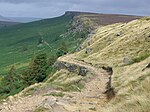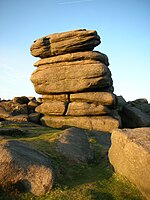Stanage Edge
Climbing areas of EnglandEscarpments of EnglandGeography of SheffieldHills and edges of South YorkshireMountains and hills of Derbyshire ... and 2 more
Mountains and hills of the Peak DistrictUse British English from October 2019

Stanage Edge, or simply Stanage (from "stone edge") is a gritstone escarpment in the Peak District, England, famous as a location for climbing. It lies a couple of miles to the north of Hathersage, and the northern part of the edge forms the border between the High Peak of Derbyshire and Sheffield in South Yorkshire. Its highest point is High Neb at 458 metres (1,503 ft) above sea level. Areas of Stanage were quarried in the past to produce grindstones, and some can still be seen on the hillside—carved, but never removed.
Excerpt from the Wikipedia article Stanage Edge (License: CC BY-SA 3.0, Authors, Images).Stanage Edge
North Lees, Derbyshire Dales
Geographical coordinates (GPS) Address Nearby Places Show on map
Geographical coordinates (GPS)
| Latitude | Longitude |
|---|---|
| N 53.347291666667 ° | E -1.6332611111111 ° |
Address
Robin Hood's Cave
North Lees
S32 1DZ Derbyshire Dales
England, United Kingdom
Open on Google Maps











